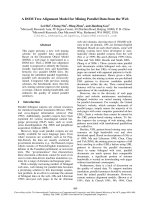21 recipes for mining twitter
Bạn đang xem bản rút gọn của tài liệu. Xem và tải ngay bản đầy đủ của tài liệu tại đây (1.02 MB, 71 trang )
Mining
Twitter
Matthew A. Russell
Distilling Rich Information from Messy Data
21 Recipes for
www.it-ebooks.info
21 Recipes for Mining Twitter
www.it-ebooks.info
www.it-ebooks.info
21 Recipes for Mining Twitter
Matthew A. Russell
Beijing
•
Cambridge
•
Farnham
•
Köln
•
Sebastopol
•
Tokyo
www.it-ebooks.info
21 Recipes for Mining Twitter
by Matthew A. Russell
Copyright © 2011 Matthew A. Russell. All rights reserved.
Printed in the United States of America.
Published by O’Reilly Media, Inc., 1005 Gravenstein Highway North, Sebastopol, CA 95472.
O’Reilly books may be purchased for educational, business, or sales promotional use. Online editions
are also available for most titles (). For more information, contact our
corporate/institutional sales department: (800) 998-9938 or
Editor: Mike Loukides
Production Editor: Kristen Borg
Proofreader: Kristen Borg
Cover Designer: Karen Montgomery
Interior Designer: David Futato
Illustrator: Robert Romano
Printing History:
February 2011: First Edition.
Nutshell Handbook, the Nutshell Handbook logo, and the O’Reilly logo are registered trademarks of
O’Reilly Media, Inc. 21 Recipes for Mining Twitter, the image of a peach-faced lovebird, and related trade
dress are trademarks of O’Reilly Media, Inc.
Many of the designations used by manufacturers and sellers to distinguish their products are claimed as
trademarks. Where those designations appear in this book, and O’Reilly Media, Inc., was aware of a
trademark claim, the designations have been printed in caps or initial caps.
While every precaution has been taken in the preparation of this book, the publisher and author assume
no responsibility for errors or omissions, or for damages resulting from the use of the information con-
tained herein.
ISBN: 978-1-449-30316-7
[LSI]
1296485191
www.it-ebooks.info
Table of Contents
Preface . . . . . . . . . . . . . . . . . . . . . . . . . . . . . . . . . . . . . . . . . . . . . . . . . . . . . . . . . . . . . . . . . . . . . vii
The Recipes . . . . . . . . . . . . . . . . . . . . . . . . . . . . . . . . . . . . . . . . . . . . . . . . . . . . . . . . . . . . . . . . . . 1
1.1 Using OAuth to Access Twitter APIs 1
1.2 Looking Up the Trending Topics 3
1.3 Extracting Tweet Entities 5
1.4 Searching for Tweets 7
1.5
Extracting a Retweet’s Origins 10
1.6
Creating a Graph of Retweet Relationships 13
1.7
Visualizing a Graph of Retweet Relationships 15
1.8 Capturing Tweets in Real-time with the Streaming API 20
1.9 Making Robust Twitter Requests 22
1.10 Harvesting Tweets 25
1.11 Creating a Tag Cloud from Tweet Entities 29
1.12 Summarizing Link Targets 34
1.13 Harvesting Friends and Followers 37
1.14 Performing Setwise Operations on Friendship Data 39
1.15 Resolving User Profile Information 43
1.16 Crawling Followers to Approximate Potential Influence 45
1.17
Analyzing Friendship Relationships such as Friends of Friends 48
1.18 Analyzing Friendship Cliques 50
1.19 Analyzing the Authors of Tweets that Appear in Search Results 52
1.20 Visualizing Geodata with a Dorling Cartogram 54
1.21 Geocoding Locations from Profiles (or Elsewhere) 58
v
www.it-ebooks.info
www.it-ebooks.info
Preface
Introduction
This intentionally terse recipe collection provides you with 21 easily adaptable Twitter
mining recipes and is a spin-off of Mining the Social Web (O'Reilly), a more compre-
hensive work that covers a much larger cross-section of the social web and related
analysis. Think of this ebook as the jetpack that you can strap onto that great Twitter
mining idea you've been noodling on—whether it’s as simple as running some dispo-
sible scripts to crunch some numbers, or as extensive as creating a full-blown interactive
web application.
All of the recipes in this book are written in Python, and if you are reasonably confident
with any other programming language, you’ll be able to quickly get up to speed and
become productive with virtually no trouble at all. Beyond the Python language itself,
you’ll also want to be familiar with easy_install ( />tools) so that you can get third-party packages that we'll be using along the way. A great
warmup for this ebook is Chapter 1 (Hacking on Twitter Data) from Mining the Social
Web. It walks you through tools like easy_install and discusses specific environment
issues that might be helpful—and the best news is that you can download a full reso-
lution copy, absolutely free!
One other thing you should consider doing up front, if you haven’t already, is quickly
skimming through the official Twitter API documentation and related development
documents linked on that page. Twitter has a very easy-to-use API with a lot of degrees
of freedom, and twitter ( a third-party package we’ll
use extensively, is a beautiful wrapper around the API. Once you know a little bit about
the API, it’ll quickly become obvious how to interact with it using twitter.
Finally—enjoy! And be sure to follow @SocialWebMining on Twitter or “like” the
Mining the Social Web Facebook page to stay up to date with the latest updates, news,
additional content, and more.
vii
www.it-ebooks.info
Conventions Used in This Book
The following typographical conventions are used in this book:
Italic
Indicates new terms, URLs, email addresses, filenames, and file extensions.
Constant width
Used for program listings, as well as within paragraphs to refer to program elements
such as variable or function names, databases, data types, environment variables,
statements, and keywords.
Constant width bold
Shows commands or other text that should be typed literally by the user.
Constant width italic
Shows text that should be replaced with user-supplied values or by values deter-
mined by context.
This icon signifies a tip, suggestion, or general note.
This icon indicates a warning or caution.
Using Code Examples
This book is here to help you get your job done. In general, you may use the code in
this book in your programs and documentation. You do not need to contact us for
permission unless you’re reproducing a significant portion of the code. For example,
writing a program that uses several chunks of code from this book does not require
permission. Selling or distributing a CD-ROM of examples from O’Reilly books does
require permission. Answering a question by citing this book and quoting example
code does not require permission. Incorporating a significant amount of example code
from this book into your product’s documentation does require permission.
We appreciate, but do not require, attribution. An attribution usually includes the title,
author, publisher, and ISBN. For example: “21 Recipes for Mining Twitter by Matthew
A. Russell (O’Reilly). Copyright 2011 Matthew A. Russell, 978-1-449-30316-7.”
If you feel your use of code examples falls outside fair use or the permission given above,
feel free to contact us at
viii | Preface
www.it-ebooks.info
Safari® Books Online
Safari Books Online is an on-demand digital library that lets you easily
search over 7,500 technology and creative reference books and videos to
find the answers you need quickly.
With a subscription, you can read any page and watch any video from our library online.
Read books on your cell phone and mobile devices. Access new titles before they are
available for print, and get exclusive access to manuscripts in development and post
feedback for the authors. Copy and paste code samples, organize your favorites, down-
load chapters, bookmark key sections, create notes, print out pages, and benefit from
tons of other time-saving features.
O’Reilly Media has uploaded this book to the Safari Books Online service. To have full
digital access to this book and others on similar topics from O’Reilly and other pub-
lishers, sign up for free at .
How to Contact Us
Please address comments and questions concerning this book to the publisher:
O’Reilly Media, Inc.
1005 Gravenstein Highway North
Sebastopol, CA 95472
800-998-9938 (in the United States or Canada)
707-829-0515 (international or local)
707-829-0104 (fax)
We have a web page for this book, where we list errata, examples, and any additional
information. You can access this page at:
/>To comment or ask technical questions about this book, send email to:
For more information about our books, courses, conferences, and news, see our website
at .
Find us on Facebook: />Follow us on Twitter: />Watch us on YouTube: />Preface | ix
www.it-ebooks.info
www.it-ebooks.info
The Recipes
1.1 Using OAuth to Access Twitter APIs
Problem
You want to access your own data or another user’s data for analysis.
Solution
Take advantage of Twitter’s OAuth implementation to gain full access to Twitter’s
entire API.
Discussion
Twitter currently implements OAuth 1.0a, an authorization mechanism expressly de-
signed to allow users to grant third parties access to their data without having to do the
unthinkable—doling out their username and password. Various third-party Python
packages such as twitter (easy_install twitter) provide easy-to-use abstractions for
performing the “OAuth dance,” so that you can easily implement client programs to
walk the user through this process. In the case of Twitter, the first step involved is
registering your application with Twitter at where Twitter
provides you with a consumer key and consumer secret that uniquely identify your ap-
plication. You provide these values to Twitter when requesting access to a user’s data,
and Twitter prompts the user with information about the nature of your request. As-
suming the user approves your application, Twitter then provides the user with a PIN
code for the user to give back to you. Using your consumer key, consumer secret, and
this PIN code, you retrieve back an access token and access token secret that ultimately
are used to get you the authorization required to access the user’s data.
Example 1-1 illustrates how to use the consumer key and consumer secret to do the
OAuth dance with the twitter package and gain access to a user’s data. To streamline
future authorizations, the access token and access token secret are written to disk for
later use.
1
www.it-ebooks.info
Example 1-1. Using OAuth to access Twitter APIs (see />-Mining-Twitter/blob/master/recipe__oauth_login.py)
# -*- coding: utf-8 -*-
import os
import sys
import twitter
from twitter.oauth import write_token_file, read_token_file
from twitter.oauth_dance import oauth_dance
def oauth_login(app_name='',
consumer_key='',
consumer_secret='',
token_file='out/twitter.oauth'):
try:
(access_token, access_token_secret) = read_token_file(token_file)
except IOError, e:
(access_token, access_token_secret) = oauth_dance(app_name, consumer_key,
consumer_secret)
if not os.path.isdir('out'):
os.mkdir('out')
write_token_file(token_file, access_token, access_token_secret)
print >> sys.stderr, "OAuth Success. Token file stored to", token_file
return twitter.Twitter(domain='api.twitter.com', api_version='1',
auth=twitter.oauth.OAuth(access_token, access_token_secret,
consumer_key, consumer_secret))
if __name__ == '__main__':
# Go to to create an app and get these items.
# See also /> APP_NAME = ''
CONSUMER_KEY = ''
CONSUMER_SECRET = ''
oauth_login(APP_NAME, CONSUMER_KEY, CONSUMER_SECRET)
Although not necessarily the norm, Twitter has conveniently opted to provide you with
direct access to your own access token and access token secret, so that you can bypass
the OAuth dance for a particular application you’ve created under your own account.
You can find a “My Access Token” link to these values under your application’s details.
These should be the same values written to the twitter.oauth file in Example 1-1, which
ultimately enables you to instantiate the twitter.Twitter object without all of the
hoopla. Note that while convenient for retrieving your own access data from your own
2 | The Recipes
www.it-ebooks.info
account, this shortcut provides no benefit if your goal is to write a client program for
accessing someone else’s data. Do the full OAuth dance in that case instead.
See Also
OAuth 2.0 spec, Authenticating Requests with OAuth, OAuth FAQ
1.2 Looking Up the Trending Topics
Problem
You want to keep track of the trending topics on Twitter over a period of time.
Solution
Use the /trends resource ( to retrieve the list of
trending topics along with Python’s built-in sleep function, in order to periodically
retrieve updates from the /trends resource.
Discussion
The /trends resource returns a simple JSON object that provides a list of the currently
trending topics. Examples 1-2 and 1-3 illustrate the approach and sample results.
Example 1-2. Discovering the trending topics (see />-Twitter/blob/master/recipe__get_trending_topics.py)
# -*- coding: utf-8 -*-
import json
import twitter
t = twitter.Twitter(domain='api.twitter.com', api_version='1')
print json.dumps(t.trends(), indent=1)
Example 1-3. Sample results for a trending topics query
{
"trends": [
{
"url": "
"name": "Ben Roethlisberger"
},
output truncated
],
"as_of": "Sun, 09 Jan 2011 23:20:30 +0000"
}
1.2 Looking Up the Trending Topics | 3
www.it-ebooks.info
You can easily extract the names of the trending topics from this data structure with
the list comprehension shown in Example 1-4.
Example 1-4. Using a list comprehension to extract trend names from a trending topics query
trends = [
trend['name']
for trend in t.trends()['trends']
]
From here, it’s a simple matter to archive them to disk as JSON, as shown in
Example 1-5.
Example 1-5. Collecting time-series data for trending topics (see />Recipes-for-Mining-Twitter/blob/master/recipe__trending_topics_time_series.py)
# -*- coding: utf-8 -*-
import os
import sys
import datetime
import time
import json
import twitter
t = twitter.Twitter(domain='api.twitter.com', api_version='1')
if not os.path.isdir('out/trends_data'):
os.makedirs('out/trends_data')
while True:
now = str(datetime.datetime.now())
trends = json.dumps(t.trends(), indent=1)
f = open(os.path.join(os.getcwd(), 'out', 'trends_data', now), 'w')
f.write(trends)
f.close()
print >> sys.stderr, "Wrote data file", f.name
print >> sys.stderr, "Zzz "
time.sleep(60) # 60 seconds
The result of the script is a directory that contains JSON data in files named by time-
stamp, and you can read back in the data by opening up a file and using the
json.loads method. Maintaining timestamped archives of tweets for a particular query
could work almost identically. Although to keep this example as simple as possible,
raw JSON is written to a file, it’s not a good practice to build up a directory with many
thousands of files in it. Just about any type of key-value store or a simple relational
schema with only a single table containing a “key” and “value” column would work
just fine. SQLite or CouchDB are good places to start looking.
4 | The Recipes
www.it-ebooks.info
See Also
/>1.3 Extracting Tweet Entities
Problem
You want to extract tweet entities such as @mentions, #hashtags, and short URLs from
search results or other batches of tweets that don’t have entities extracted.
Solution
Use the twitter_text ( package’s Extractor
class to extract the tweet entities.
Discussion
As of January 2011, the /search resource does not provide any opt-in parameters for
the automatic extraction of tweet entities as is the case with other APIs such as the
various /statuses resources, but you can use twitter_text (easy_install twitter-
text-py) to extract entities in the very same way that Twitter extracts them in produc-
tion. The twitter_text package is implemented to the same specification as the
twitter-text-rb Ruby gem ( that Twitter
uses on its internal platform. Example 1-6 illustrates a typical usage of twitter_text.
Example 1-6. Extracting Tweet entities (see />-Twitter/blob/master/recipe__extract_tweet_entities.py)
# -*- coding: utf-8 -*-
import json
import twitter_text
def get_entities(tweet):
extractor = twitter_text.Extractor(tweet['text'])
# Note: the production Twitter API contains a few additional fields in
# the entities hash that would require additional API calls to resolve.
# See API resources that offer the include_entities parameter for details.
entities = {}
entities['user_mentions'] = []
for um in extractor.extract_mentioned_screen_names_with_indices():
entities['user_mentions'].append(um)
entities['hashtags'] = []
for ht in extractor.extract_hashtags_with_indices():
1.3 Extracting Tweet Entities | 5
www.it-ebooks.info
# Massage field name to match production twitter api
ht['text'] = ht['hashtag']
del ht['hashtag']
entities['hashtags'].append(ht)
entities['urls'] = []
for url in extractor.extract_urls_with_indices():
entities['urls'].append(url)
return entities
if __name__ == '__main__':
# A mocked up array of tweets for purposes of illustration.
# Assume tweets have been fetched from the /search resource or elsewhere.
tweets = \
[
{
'text' : 'Get @SocialWebMining example code at #w00t'
# more tweet fields
},
# more tweets
]
for tweet in tweets:
tweet['entities'] = get_entities(tweet)
print json.dumps(tweets, indent=1)
Sample results follow in Example 1-7.
Example 1-7. Sample extracted Tweet entities
[
{
"text": "Get @SocialWebMining example code at #w00t",
"entities": {
"user_mentions": [
{
"indices": [
4,
20
],
"screen_name": "SocialWebMining"
}
],
6 | The Recipes
www.it-ebooks.info
"hashtags": [
{
"indices": [
58,
63
],
"text": "w00t"
}
],
"urls": [
{
"url": "
"indices": [
37,
57
]
}
]
}
}
]
Whenever possible, use the include_entities parameter in requests to have Twitter
automatically extract tweet entities for you. But in circumstances where the API re-
sources currently require you to do the heavy lifting, you now know how to easily
extract the tweet entities for rapid analysis.
See Also
/>1.4 Searching for Tweets
Problem
You want to collect a sample of tweets from the public timeline for a custom query.
Solution
Use the /search resource to perform a custom query.
Discussion
Example 1-8 illustrates how to use the /search resource to perform a custom query
against Twitter’s public timeline. Similar to the way that search engines work, Twit-
ter’s /search resource returns results on a per page basis, and you can configure the
number of results per page using the page and rpp (results per page) keyword parame-
ters. As of January 2011, the maximum number of search results that you can retrieve
per query is 1,500.
1.4 Searching for Tweets | 7
www.it-ebooks.info
Example 1-8. Searching for tweets by query term (see />-Mining-Twitter/blob/master/recipe__search.py)
# -*- coding: utf-8 -*-
import sys
import json
import twitter
Q = ' '.join(sys.argv[1])
MAX_PAGES = 15
RESULTS_PER_PAGE = 100
twitter_search = twitter.Twitter(domain="search.twitter.com")
search_results = []
for page in range(1,MAX_PAGES+1):
search_results += \
twitter_search.search(q=Q, rpp=RESULTS_PER_PAGE, page=page)['results']
print json.dumps(search_results, indent=1)
Example 1-9 displays truncated results for a StrataConf query.
Example 1-9. Sample search results for StrataConf
[
{
"next_page": "?page=2&max_id=24284287591256064&rpp=100&q=StrataConf",
"completed_in": 0.187719,
"max_id_str": "24284287591256064",
"since_id_str": "0",
"refresh_url": "?since_id=24284287591256064&q=StrataConf",
"results": [
{
"iso_language_code": "en",
"to_user_id_str": null,
"text": "RT @ptwobrussell: Generating Dynamic Social Networks ",
"from_user_id_str": "142175715",
"profile_image_url": " ",
"id": 24266314180730880,
"source": "<a href="" rel="nofollow">Tweetie for Mac</a>",
"id_str": "24266314180730880",
"from_user": "dreasoning",
"from_user_id": 142175715,
"to_user_id": null,
"geo": null,
"created_at": "Mon, 10 Jan 2011 00:48:34 +0000",
"metadata": {
"result_type": "recent"
}
},
output truncated
8 | The Recipes
www.it-ebooks.info
],
"since_id": 0,
"results_per_page": 100,
"query": "StrataConf",
"max_id": 24284287591256064,
"page": 1
}
]
You can distill the 140 character text field from each tweet in search_results using a
list comprehension, as shown in Example 1-10:
Example 1-10. Using a list comprehension to extract tweet text from search results
print [ result['text']
for result in search_results ]
Writing out search_results (or just about anything else) to a file as raw JSON with
Python’s built-in file object is easily accomplished—Example 1-5 includes an overview
of how to use file and json.dumps to achieve that end.
It might be the case that you’d like to display some results from a /trends query, and
prompt the user for a selection that you feed into the /search resource as a targeted
query. Python’s built-in raw_input function can be used precisely for this purpose—
Example 1-11 shows you how to make it all happen by using raw_input to glue together
Example 1-2 and Example 1-8, and then performing a little post-processing with
Example 1-6.
Example 1-11. Searching for trending topics (see />-Twitter/blob/master/recipe__get_search_results_for_trending_topic.py)
# -*- coding: utf-8 -*-
import os
import sys
import json
import twitter
from recipe__extract_tweet_entities import get_entities
MAX_PAGES = 15
RESULTS_PER_PAGE = 100
# Get the trending topics
t = twitter.Twitter(domain='api.twitter.com', api_version='1')
trends = [
trend['name']
for trend in t.trends()['trends']
]
1.4 Searching for Tweets | 9
www.it-ebooks.info
idx = 0
for trend in trends:
print '[%i] %s' % (idx, trend,)
idx += 1
# Prompt the user
trend_idx = int(raw_input('\nPick a trend: '))
q = trends[trend_idx]
# Search
print >> sys.stderr, 'Fetching tweets for %s ' % (q, )
twitter_search = twitter.Twitter(domain="search.twitter.com")
search_results = []
for page in range(1,MAX_PAGES+1):
search_results += \
twitter_search.search(q=q, rpp=RESULTS_PER_PAGE, page=page)['results']
# Extract tweet entities and embed them into search results
for result in search_results:
result['entities'] = get_entities(result)
if not os.path.isdir('out'):
os.mkdir('out')
f = open(os.path.join(os.getcwd(), 'out', 'search_results.json'), 'w')
f.write(json.dumps(search_results, indent=1))
f.close()
print >> sys.stderr, "Entities for tweets about trend '%s' saved to %s" % (q, f.name,)
See Also
/>1.5 Extracting a Retweet’s Origins
Problem
You want to extract the originating source from a retweet.
Solution
If the tweet’s retweet_count field is greater than 0, extract name out of the tweet’s user
field; also parse the text of the tweet with a regular expression.
10 | The Recipes
www.it-ebooks.info
Discussion
Although the retweet concept was a grassroots phenomenon that evolved with Twit-
ter’s users, the platform has since evolved to natively incorporate retweeting. As a case
in point, /status resources in the Twitter platform are now capable of handling a re-
tweet action such that it’s no longer necessary to explicitly express the origin of the
tweet with conventions such as “RT @user” or “(via @user)” in the 140 character limit.
Instead, the tweet itself contains a retweet_count field that expresses the number of
times the tweet has been retweeted. If the retweet_count field is greater than 0, it means
that the tweet has been retweeted and you should inspect name from the user field
encoded into the tweet.
However, keep in mind that even though Twitter’s platform now accommodates re-
tweeting at the API level, not all popular Twitter clients have adapted to take advantage
of this feature, and there’s a lot of archived Twitter data floating around that doesn’t
contain these fields. Another possibility is that even though someone’s Twitter client
uses the retweet API, they might also manually annotate the tweet with additional “RT”
or “via” criteria of interest. Finally, to throw one more wrench in the gears, note that
tweets returned by the /search resource do not contain the retweet_count as of January
2011. Thus, any way you cut it, inspecting the text of the tweet is still a necessity.
Fortunately, a relatively simple regular expression can handle these issues fairly easily.
Example 1-12 illustrates a generalized approach that should work well in many
circumstances.
Example 1-12. Extracting retweet origins (see />Twitter/blob/master/recipe__get_rt_origins.py)
# -*- coding: utf-8 -*-
import re
def get_rt_origins(tweet):
# Regex adapted from
# /> rt_patterns = re.compile(r"(RT|via)((?:\b\W*@\w+)+)", re.IGNORECASE)
rt_origins = []
# Inspect the tweet to see if it was produced with /statuses/retweet/:id
# See />
if tweet.has_key('retweet_count'):
if tweet['retweet_count'] > 0:
rt_origins += [ tweet['user']['name'].lower() ]
# Also, inspect the tweet for the presence of "legacy" retweet
# patterns such as "RT" and "via".
1.5 Extracting a Retweet’s Origins | 11
www.it-ebooks.info
try:
rt_origins += [
mention.strip()
for mention in rt_patterns.findall(tweet['text'])[0][1].split()
]
except IndexError, e:
pass
# Filter out any duplicates
return list(set([rto.strip("@").lower() for rto in rt_origins]))
if __name__ == '__main__':
# A mocked up array of tweets for purposes of illustration.
# Assume tweets have been fetched from the /search resource or elsewhere.
tweets = \
[
{
'text' : 'RT @ptowbrussell Get @SocialWebMining at #w00t'
# more tweet fields
},
{
'text' : 'Get @SocialWebMining example code at #w00t',
'retweet_count' : 1,
'user' : {
'name' : 'ptwobrussell'
# more user fields
}
# more tweet fields
},
# more tweets
]
for tweet in tweets:
print get_rt_origins(tweet)
Although this task is a little bit more complex than it would be in an ideal Twitterverse,
the good news is that you're now equipped with a readily reusable routine to take
care of the mundane labor, so that you can focus on more interesting analysis and
visualization.
12 | The Recipes
www.it-ebooks.info
See Also
/>-more/, />velopment-talk/browse_thread/thread/4b08544f2c02d68f
1.6 Creating a Graph of Retweet Relationships
Problem
You want to construct and analyze a graph data structure of retweet relationships for
a set of query results.
Solution
Query for the topic, extract the retweet origins, and then use the NetworkX package
to construct a graph to analyze.
Discussion
Recipe 1.4 can be used to assemble a collection of related tweets, and Recipe 1.5 can
be used to extract the originating authors, if any, from those tweets. Given these retweet
relationships, all that’s left is to use the networkx ( package
(easy_install networkx) to construct a directed graph that represents these relation-
ships. At the most basic level, nodes on the graph represent the originating authors and
retweet authors, while edges convey the id of the tweet expressing the relationship.
NetworkX contains a slew of useful functions for analyzing graphs that you construct,
and Example 1-13 is just about the absolute minimum working example that you’d
need to get the gist of how things work.
Example 1-13. Creating a graph using NetworkX
# -*- coding: utf-8 -*-
import networkx as nx
g = nx.Graph()
g.add_edge("@user1", "@user2")
g.add_edge("@user1", "@user3")
g.add_edge("@user2", "@user3")
Complete details on the many virtues of NetworkX can be found in its online docu-
mentation, and this simple example is intended only to demonstrate how easy it really
is to construct the actual graph once you have the underlying data that you need to
represent the nodes in the graph.
1.6 Creating a Graph of Retweet Relationships | 13
www.it-ebooks.info
Once you have the essential machinery for processing the tweets in place, the key is to
loop over the tweets and repeatedly call add_edge on an instance of networkx.Digraph.
Example 1-14 illustrates and displays some of the most rudimentary characteristics of
the graph.
Example 1-14. Creating a graph of retweet relationships (see />-for-Mining-Twitter/blob/master/recipe__create_rt_graph.py)
# -*- coding: utf-8 -*-
import sys
import json
import twitter
import networkx as nx
from recipe__get_rt_origins import get_rt_origins
def create_rt_graph(tweets):
g = nx.DiGraph()
for tweet in tweets:
rt_origins = get_rt_origins(tweet)
if not rt_origins:
continue
for rt_origin in rt_origins:
g.add_edge(rt_origin.encode('ascii', 'ignore'),
tweet['from_user'].encode('ascii', 'ignore'),
{'tweet_id': tweet['id']}
)
return g
if __name__ == '__main__':
# Your query
Q = ' '.join(sys.argv[1])
# How many pages of data to grab for the search results.
MAX_PAGES = 15
# How many search results per page
RESULTS_PER_PAGE = 100
# Get some search results for a query.
twitter_search = twitter.Twitter(domain='search.twitter.com')
search_results = []
for page in range(1,MAX_PAGES+1):
14 | The Recipes
www.it-ebooks.info









